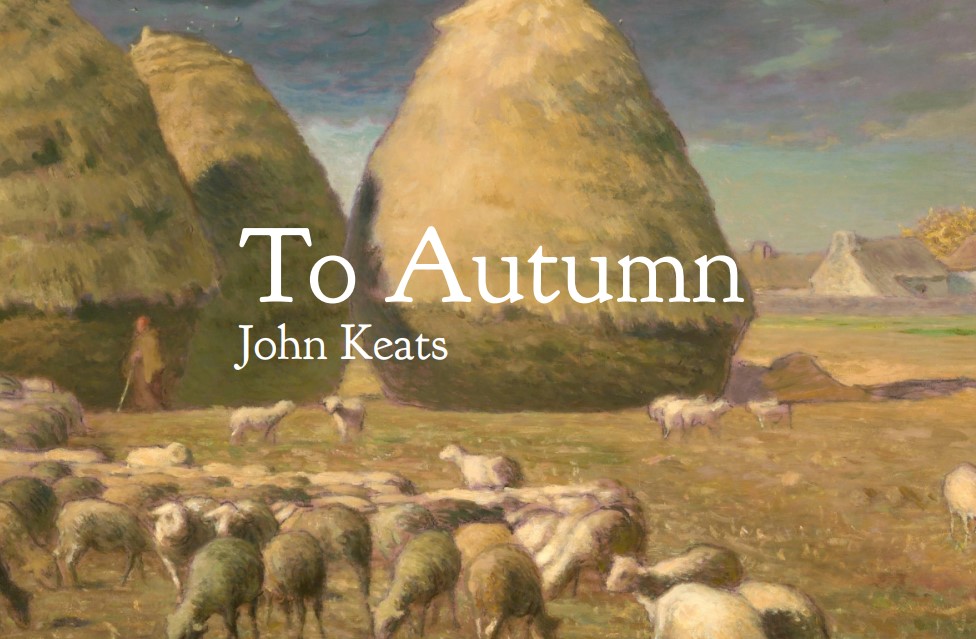Below, you’ll find an A-grade essay on To Autumn which focuses specifically on the beauty of nature in the poem. Though it achieved a good grade, it’s not perfect! As you read through, try to make your own notes on how it is successful, and where it could have been better. Then, read the feedback at the end of the document to compare your notes with a teacher’s assessment.
THE QUESTION
How does Keats explore the beauty of nature in ‘To Autumn’?.
THE ESSAY
In his poem “To Autumn,” John Keats explores the beauty of nature through a celebration of the season of autumn. The poem is a tribute to the season and its bountiful harvest, as well as a reflection on the passage of time and the inevitability of change. Through the use of rich imagery and sensory language, Keats captures the essence of autumn, highlighting its beauty and the way it speaks to the human experience.
In “To Autumn,” Keats explores the theme of nature through his celebration of the season of autumn. The poem is a tribute to the season and its bountiful harvest, as well as a reflection on the passage of time and the inevitability of change. Keats uses rich sensory imagery to capture the essence of the season, highlighting its warmth, abundance, maturity and tranquility. In the first stanza, Keats describes the “mellow fruitfulness” of the season, as well as the fact that Autumn is a “close-bosom’d friend of the maturing sun”, conveying a sense of warmth and abundance through imagery and personification. The term “close-bosom’d” implies that the sun and the season work in harmony together to produce the rich harvest that the world enjoys at this time of year.
Eve of St Agnes by John Keats – Study Questions
Secondly, Keats continues to use imagery to convey the beauty of the natural countryside setting, describing the “full-grown lambs” and the “hedgerows, white” with a “Cricket on the hearth” which convey a sense of abundance. These images establish the poem as being in the pastoral genre, which explores the beauty of the natural world and the simplicity of rural life. Typically, pastoral poetry depicts the idyllic yet simplistic life of working country folk, who exist in harmony with nature. In ‘To Autumn’, this is most clearly seen through the comic characterisation of the season of Autumn, which is personified as a shepherd lad or farm worker ‘Drows’d with the fume of poppies’, sitting by the ‘cyder-press’, watching drops of alcohol ‘oozing’ from it. This symbolically demonstrates that Autumn is a season where people should let go, and enjoy themselves – perhaps not working too hard, or taking life too seriously.
Finally, the fact that Autumn is a season which happens only once a year, for a few brief months, makes it all the more special and beautiful. In the third stanza, Keats reflects on the passage of time, as the speaker observes the “breathing peace” of the season and the “soft-dying day,” conveying a sense of tranquility and acceptance of the inevitability of change. Keats himself was often concerned by the swift passage of time; his letters reveal that he often felt that he hadn’t achieved enough, or that he wasn’t able to produce as great a body of work as he’d like. Therefore, the fact that time in the poem is portrayed as a natural and beautiful phenomenon perhaps suggests that Keats was trying to encourage himself to accept the seasons and the way in which time flows.
In conclusion, Keats explores the beauty of nature in “To Autumn” through the celebration of the season of autumn. He uses rich imagery and sensory language to capture the essence of the season, highlighting its warmth, abundance, maturity and tranquility. The poem serves as a tribute to the season and its bountiful harvest, as well as a reflection on the passage of time and the inevitability of change.
FEEDBACK:
- Excellent structure – with a clear intro, conclusion and middle paragraphs with topic sentences
- Some great use of contextual details – especially the application of the pastoral genre
- A good understanding of the different ways in which nature relates to the poem
- The language analysis is done well in parts – but it could be applied more deeply and consistently; a greater range of poetic techniques should be used
- Structural analysis is very minimal – greater insight into structure would help here
- A good sensitivity to the deeper themes and ideas of the poem – using Romanticism and exploring Romantic themes may help you to open up your ideas further
- Good academic register
- No need to mention techniques in the intro or conclusion – try to analyse them more precisely, relating to specific quotations
Thanks for reading! To read our analysis of the poem ‘To Autumn’, including a breakdown of the story and meaning, click here.
If you need help with John Keats’s Literature, we have an in-depth course dedicated to him and his poetry, which you can access by clicking here.
For all our English Literature and Language courses, click here.












